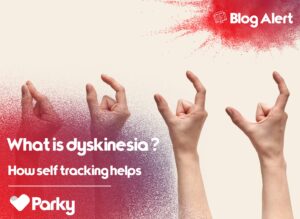

Dyskinesia, a challenging aspect of Parkinson's disease, can significantly impact the lives of those affected. As it is closely tied to medication treatments, self-tracking could aid in optimizing treatment plans.
Dyskinesia is characterized by involuntary, often rhythmic, movements that can manifest as twitches, jerks, or dance-like motions. It is closely associated with long-term use of levodopa, a primary medication for managing Parkinson's symptoms. These movements tend to occur when other Parkinson's symptoms, like tremors, stiffness, and slowness, are well controlled, often in times referred to as being "on" with dyskinesia. Stress or excitement can also trigger dyskinesia, adding complexity to daily life.
Causes of Dyskinesia:
The development of dyskinesia is complex and primarily linked to prolonged levodopa use, particularly in individuals who have had Parkinson's for several years. Other factors, such as younger age at diagnosis and higher levodopa doses, increase the risk of dyskinesia. Changes in brain chemicals like serotonin, glutamate, and dopamine are believed to contribute to its development. Fluctuating dopamine levels, due to the intermittent nature of levodopa intake and ongoing dopamine cell loss, play a significant role in the emergence of dyskinesia.
Effects of Dyskinesia on people living with Parkinson's:
Living with dyskinesia can be challenging, with individuals experiencing varying degrees of discomfort or even pain. These involuntary movements can affect one or multiple body parts. Dyskinesia typically occurs when other Parkinson's symptoms are well managed, complicating symptom control. Stress and excitement can exacerbate dyskinesia, impacting daily activities, exercise, and social interactions.
Treatment Options for Dyskinesia: To effectively manage dyskinesia, personalized treatment plans are essential. Here are some treatment options to consider:
Tracking Dyskinesia: How It Helps
Tracking dyskinesia plays a pivotal role in improving the lives of people living with Parkinson's disease. By actively monitoring these involuntary movements, patients and healthcare providers can gain valuable insights into their condition. Here's how tracking dyskinesia can make a significant difference:
1. Self-Awareness: Tracking dyskinesia allows individuals to become more self-aware of their symptoms, identifying patterns, triggers, and variations in their movements. This heightened awareness enables patients to proactively manage their condition by making informed decisions about daily activities and medication intake.
2. Personalized Treatment: The data collected through self-tracking serves as a powerful tool for healthcare providers to tailor treatment plans. Understanding the frequency, duration, and intensity of dyskinesia episodes allows for medication adjustments and therapy modifications that are better aligned with the individual's unique needs.
3. Improved Communication: Dyskinesia tracking bridges the communication gap between patients and healthcare professionals. The data becomes a common language, facilitating clearer discussions about symptom management and treatment options. This enhanced communication fosters a more collaborative approach to care.
4. Timely Interventions: Real-time tracking offers the advantage of early symptom detection. Patients can identify potential issues and report them to their healthcare providers promptly. This proactive approach allows for timely adjustments in medication dosages or therapies, minimizing the disruptive effects of dyskinesia on daily life.
5. Lifestyle Adjustments: Tracking dyskinesia goes beyond medication management. It provides insights into how lifestyle factors such as stress, sleep, and dietary choices impact symptom severity. Armed with this knowledge, individuals can make lifestyle adjustments that complement medical interventions, contributing to an overall improvement in well-being.
6. Objective Documentation: Dyskinesia tracking provides objective documentation of symptom progression. This data is invaluable for both patients and healthcare providers in assessing the effectiveness of treatment plans over time. It helps in fine-tuning interventions to achieve optimal results.
The Role of Parky in Dyskinesia Management: Parky is a revolutionary Apple Watch app for Parkinson's disease to empower Parkinson's patients and their healthcare providers. It goes beyond tracking symptoms such as tremor and dyskinesia; Parky provides invaluable insights into the correlation between these symptoms and medication intake.
Real-Time Monitoring: Parky offers continuous, real-time data on tremor and dyskinesia via Apple Watch, allowing patients to track their symptoms as they happen.
Insights and Correlations: Parky's FDA-cleared advanced algorithms analyze the data to uncover correlations between symptom severity, medication intake, and other factors. This information is presented in a user-friendly format.
Personalized Treatment Plans: Armed with Parky insights, patients and healthcare providers can collaboratively create personalized treatment plans. These plans optimize medication timing and dosages, minimizing symptom fluctuations and dyskinesia.
Enhanced Communication: Parky data acts as a common language between patients and healthcare professionals, facilitating clearer communication and a deeper understanding of the individual's condition.
Proactive Adjustments: Parky's real-time insights enable early identification of potential issues. This proactive approach allows for timely adjustments in medications or therapies, reducing the impact of dyskinesia on daily life.
Parky is a prescription-use-only product. To start using Parky today, talk to your healthcare provider and download the app from the Apple Store.
Is tardive dyskinesia related to Parkinson's disease?
Tardive dyskinesia and Parkinson's disease are related in the sense that both conditions involve movement disorders, but they are distinct and have different causes.
Tardive Dyskinesia: Tardive dyskinesia is a condition characterized by repetitive, involuntary movements of the face, tongue, lips, and other body parts. It is often associated with long-term use of certain medications, particularly antipsychotic drugs used to treat conditions like schizophrenia and bipolar disorder. Tardive dyskinesia can develop after months or years of taking these medications, and its exact cause is not fully understood. It is not directly related to Parkinson's disease.
What is the difference between dyskinesia and dystonia?
Dyskinesia and dystonia are both movement disorders, but they differ in their characteristics, symptoms, and underlying mechanisms:
Dyskinesia:
Dystonia:
While both dyskinesia and dystonia involve abnormal movements, dyskinesia is characterized by involuntary, often rhythmic movements that may resemble dance-like motions and are commonly associated with Parkinson's disease and its treatment. Dystonia, on the other hand, involves sustained muscle contractions leading to abnormal postures or twisting movements and can occur as a primary condition or due to other factors. The key distinction lies in the nature and appearance of the movements, as well as their underlying causes.
Join our community in spreading hope and strength. Tell us your unique journey with Parkinson's to uplift and empower others.